

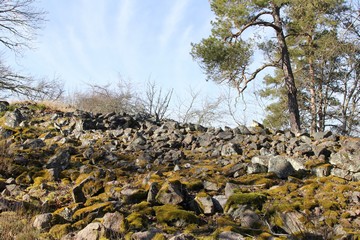
Queen Omma is said to have lived in the northernmost fort, just above Borghamn. A local girl was abducted to the fort to be raised as a new queen after the old one. The queen always wore a mask. Granmar, who had betrothed his fiancée to Omma, sought out and killed her, only to discover that it was the fiancée he had killed. The exchange had already taken place.
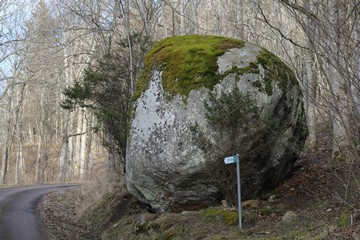
The largest boulder came dangling all the way from Västergötland and is named after the giant who threw it. There is an aggressive and a peaceful version of the motive for this giant throw. The first was anger at Heda Church, the second that the giant Per wanted to help the monks who were building Alvastra Monastery. The monks were short of materials. Per chose the biggest block of stone he could find in Tiveden and threw it over. As usual, the stone did not reach its destination, so today it remains where it ended up, along the lakeroad, to the delight of today's tourists but hardly to the monks who built the monastery.
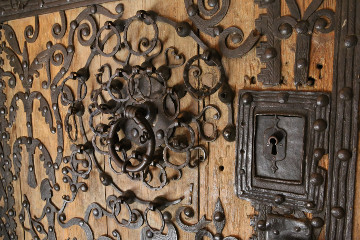
There is an old folk tale about the Rogslosa door. According to it, many trolls lived in Rödgavel's cave on Omberg. One day they were going to have a wedding party and they invited all the trolls in the area, but the Västgöta trolls were not invited. They were terribly angry. They travelled across the lake (Vättern) to Rogslösa church, where they stole holy water. They splashed it on all the wedding guests and the hosts. Then the view of the Omberg trolls and their guests was reversed, and they began to destroy each other. Meanwhile, the Västgötatrollen ate the good wedding food. While the trolls were busy with their mutual troubles, ordinary people from Rogslösa came to see what was going on. When they discovered the tumult, they took the opportunity to steel the troll's fine pigsty door and put it in their new church in Rogslösa.
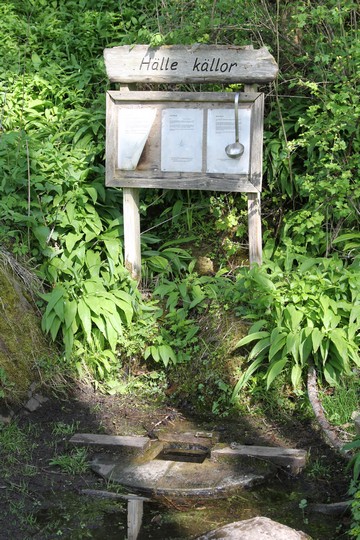
Once upon a time, a very long time ago, a man named Häll lived on Omberg. When he came home one day from a journey, someone whispered in his ear that his wife had been unfaithful. He became wild and crazy with jealousy and threatened her life if she did not confess. She swore her innocence. After some time, when they were riding to Borghamn and came to a lonely place, he again demanded that she confess. When she did not, he took his sword and killed her. Before she died, she declared that, as proof of her innocence, three springs would flow in the place. This happened and they have since been called Hälle springs.
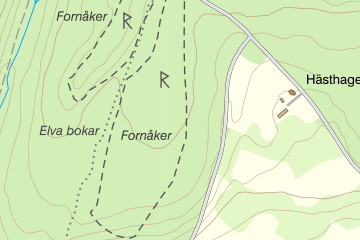
Eleven beeches was a magnificent tree with eleven stems that grew in a circle from a single root. Originally there were twelve trunks and it was also called the Beech tree of the Apostles. But then a farmer in the 17th century thought that Judas should not be permitted and cut down a trunk. He shouldn't have done that because soon afterwards he fell ill and died.
Carl von Linné describes eleven beeches when he visited Omberg in 1741: "North of the hill (Hjässan) a fair distance away we saw the apostle tree, which was a large beech with eleven trunks, which rose from the root, no doubt grown from as many nuts, although the trunks were somewhat overgrown below. Of these eleven, one was withered in the centre. There was no sign of the twelfth; so I do not know whether the story is true that a peasant cut off the twelfth stem, pretending that Christ had no more than eleven apostles after Judas hanged himself."
Anyone looking for the 'giant beech' today does so in vain. Beeches don't last more than 150 years, although there are 400-year exceptions. Eleven beeches must have been one of them.
In 1845 there were still six trunks left, forming a large room that could seat ten to twelve people. In 1864 it was mostly dried up and in 1891 it was completely gone.
A number of names are said to have been carved into the bark of the "Eleven Beeches", including Charles XI and Charles XII.
Strangely enough, eleven beech trees can still be seen today, but they do not grow from the same root and are also planted on Hjässatorget. Twelve beech trees have been planted there, but one is said not to have survived.
We should perhaps also mention another notable pair of beech trees, Adam and Eve. They were two beech trees growing together with a diameter of about two metres. In the winter of 1889, however, the giant tree was blown down in a storm and, despite its hollow trunk, left 20 cubic metres of wood behind.
Oral traditions describe Omma as a very beautiful woman, who had plenty of suitors and love problems. She was most desired by the red-bearded giant Rödgavel. After seeing Omma and her bridesmaids dancing on Stocklycke meadow one early morning, he was head over heels in love, but seems to have had no response to his hot feelings. Once, however, Rödgavel had managed to lure the beautiful queen into a mountain cave. When he started getting close, Omma complained about the intense heat in the cave. When Rödgavel glanced at the door, Omma took the opportunity to transform herself into a misty veil, which danced elusively down over Hästholmen bay, up Ålebäcken and out over Tåkern. The giant who tried to follow stepped into Dags mosse and drowned.

Rödgavel's most dangerous rival was a giant from Västergötland called Ringabergsbusen. Once he came riding across the ice of Lake Vättern to court Omma, who was waiting on the mountain. As he spurred his horse to take the leap up the Rödgavel slope, the horse struck its hoof on the rock face. Both horse and rider fell back onto the ice, which broke and both drowned. Since then, Queen Omma sits on the mountain and cries. Her tears run down into Rödgavel's cave, which is why it always drips from the roof there. Where the giant's horse hit the rock wall, a ten metre wide mark appeared, which is now known as the Rödgavel's gate.
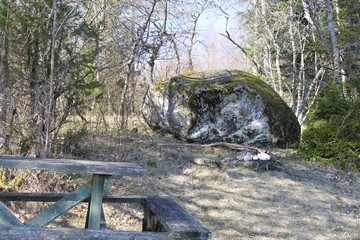
The large stone on Marsafällan above Steneborg was rolled here by a giant called Mars. The name comes from the fact that he only became visible in March, because he slept all winter under this stone, which was then located further up the mountain. One spring, when the giant was in a hurry to get out of his den, he took a little too much, so the stone started to roll and ended up here. The giant drowned in his cave, which quickly filled with water.